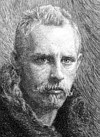Fridtjof Nansen

Fridtjof Nansen's first major contribution to oceanography was the transpolar expedition made by freezing vessel "Fram" in the Arctic drift ice north of the New Siberian Islands in 1893. He made several improvements in measuring techniques (for both physical and biological parameters) and in our understanding of ocean processes.
It was Fridtjof Nansen who gave Vang Walfrid Ekman the impetus to study the dead water (internal wave) phenomena and the effects of the Earth's rotation on wind induced currents. It is said, that after an inspiring lecture by Nansen, Ekman solved the problem overnight, producing the well known spiral solution. Nansen's concept of "dirty ice" has attained a renaissance in our age of ocean pollution.
In the early part of this century, Nansen, together with Björn Helland-Hansen, made several original studies of the Nordic Seas. It was after this research that he became a diplomat and champion of international justice through his work for the League of Nations. The Nansen passport and his work for the hungry, the homeless and the victims of world events led to his receipt of the Nobel Peace Prize.
John Johnson
